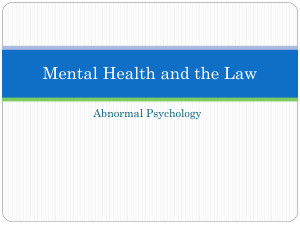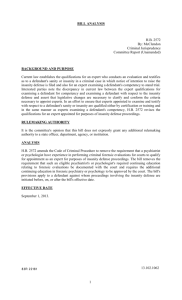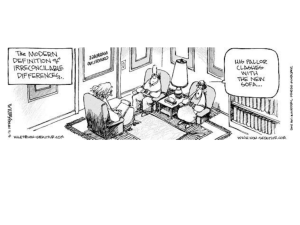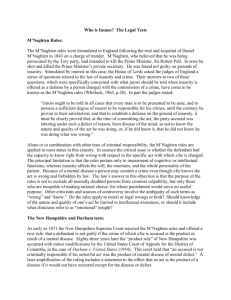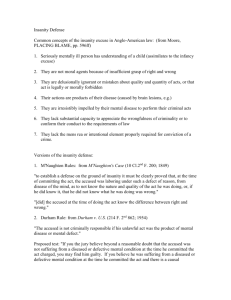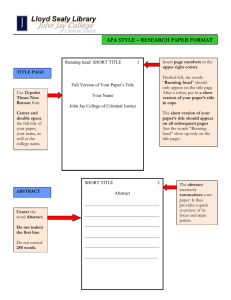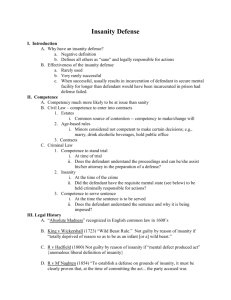The Federal Insanity Defense Reform Act
advertisement
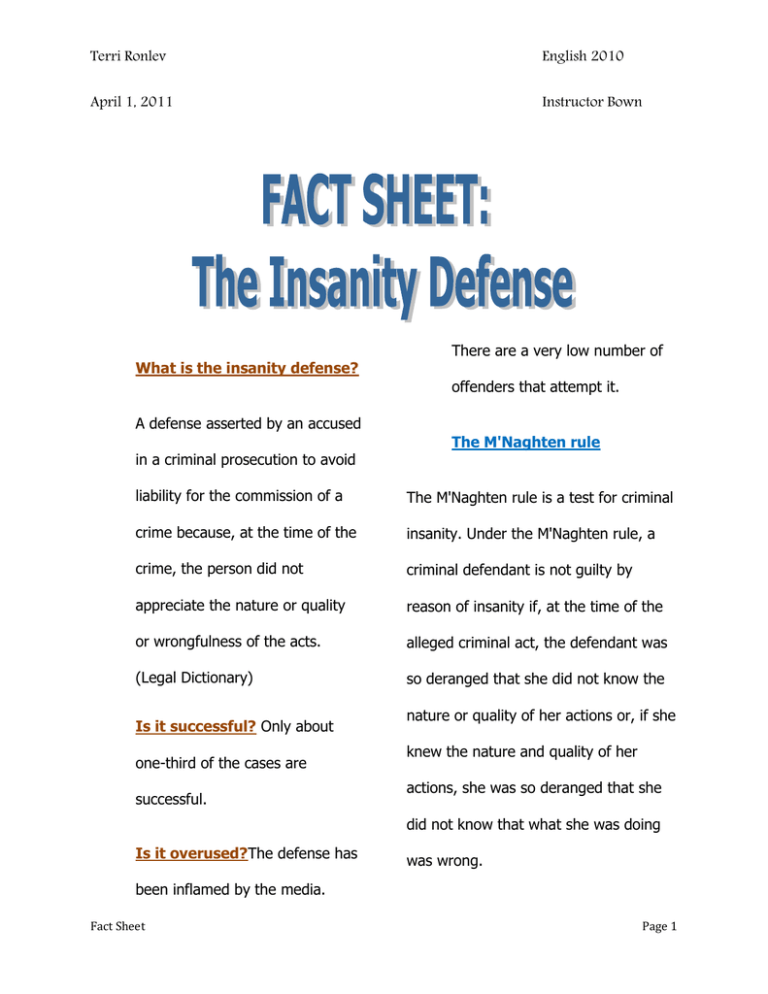
Terri Ronlev English 2010 April 1, 2011 Instructor Bown What is the insanity defense? There are a very low number of offenders that attempt it. A defense asserted by an accused in a criminal prosecution to avoid The M'Naghten rule liability for the commission of a The M'Naghten rule is a test for criminal crime because, at the time of the insanity. Under the M'Naghten rule, a crime, the person did not criminal defendant is not guilty by appreciate the nature or quality reason of insanity if, at the time of the or wrongfulness of the acts. alleged criminal act, the defendant was (Legal Dictionary) so deranged that she did not know the Is it successful? Only about one-third of the cases are successful. nature or quality of her actions or, if she knew the nature and quality of her actions, she was so deranged that she did not know that what she was doing Is it overused?The defense has was wrong. been inflamed by the media. Fact Sheet Page 1 Terri Ronlev English 2010 April 1, 2011 Instructor Bown The M'Naghten rule on criminal insanity later overturned in the case U.S. v. is named for Daniel M'Naghten, who, in Brawner, 471 F.2d 969 (1972). After the 1843, tried to kill England's prime 1970s, U.S. jurisdictions have tended to minister Sir Robert Peel. M'Naghten not recognize this argument as it places thought Peel wanted to kill him, so he emphasis on "mental disease or defect" tried to shoot Peel but instead shot and and thus on testimony by psychiatrists killed Peel's secretary, Edward and is argued to be somewhat Drummond. Medical experts testified ambiguous. that M'Naghten was psychotic, and M'Naghten was found not guilty by The "Model Penal Code" Test for Legal Insanity reason of insanity”(legal-dictionary). In response to the criticisms of the The Durham Rule various tests for the insanity defense, The Durham Rule or "product test" was the American Law Institute (ALI) adopted by the United States Court of designed a new test for its Model Penal Appeals for the District of Columbia Code in 1962. Under this test, "a person Circuit in 1954, in the case of Durham v. is not responsible for criminal conduct if U.S. (214 F.2d 862), and states that "... at the time of such conduct as a result an accused is not criminally responsible of mental disease or defect he lacks if his unlawful act was the product of substantial capacity either to appreciate mental disease or defect". Durham was the criminality of his conduct or to Fact Sheet Page 2 Terri Ronlev English 2010 April 1, 2011 Instructor Bown conform his conduct to the requirements Irresistible Impulse Test, and the of the law." diagnosis of mental disease and defect The Model Penal Code test is much required by Durham. broader than the M'Naghten Rule and This broad based rule received wide the Irresistible Impulse Test. It asks acceptance, and by 1982 all federal whether defendants have a substantial courts and a majority of state courts incapacity to appreciate the criminality had adopted the ALI test. While some of their conduct or to conform their states have since dropped the ALI test, conduct to the law rather than the and it no longer applies at the federal absolute knowledge required by level, 18 states still use the ALI test in M'Naghten and the absolute inability to their definitions of insanity (Findlaw). control conduct required by the Irresistible Impulse Test. The ALI test also requires that the mental disease or defect be a mental diagnosis. In this way, it manages to incorporate elements of all three of its predecessors: the knowledge of right and wrong required by M'Naghten, the prerequisite of lack of control in the Fact Sheet Current Application of the Insanity Defense The question of who has the burden of proof with an insanity defense has been a source of controversy. Before the Hinckley verdict, a majority of states had the burden of proof rest with the state; that is, the prosecutor had to prove Page 3 Terri Ronlev English 2010 April 1, 2011 Instructor Bown that the defendant was not insane. confined for longer than their After the Hinckley verdict, the vast prison terms would have been. In majority of states required the the case of Jones v. United States, defense to prove that the the Supreme Court in 1983 backed defendant was indeed insane. In this proposition, ruling that the states where the burden is on the sentence that criminal defendants defense to prove insanity, the would have received had they been defense is required to show either convicted should have no bearing by clear and convincing evidence or on how long they could be by a preponderance of the evidence committed to a mental hospital. that the defendant is insane. In states where the burden is still on prosecutors to prove sanity, they are required to prove it beyond a reasonable doubt. After Hinckley, many states changed their commitment policies to ensure that a defendant found not guilty by reason of insanity would be required to stay in a Contrary to uninformed opinion, mental hospital for a certain period defendants found not guilty by of time for evaluation following reason of insanity are not simply acquittal. Previously, no time was released from custody. They are specified. Also, several states generally committed to mental changed the burden of proof for hospitals where they can be Fact Sheet Page 4 Terri Ronlev English 2010 April 1, 2011 Instructor Bown release from the state to proving the defense of insanity by defendants. clear and convincing evidence." The Federal Insanity Defense Reform Act Previously under federal law, the government had the burden of proving sanity. The federal Insanity Defense Reform Act of 1984, codified at 18 Guilty but Mentally Ill U.S.C. § 17, provides: "It is an Finally, the Hinckley verdict affirmative defense to a accelerated the adoption of "guilty prosecution under any Federal but mentally ill" verdicts by states. statute that, at the time of the The "guilty but mentally ill" verdict commission of the acts constituting allows mentally ill defendants to be the offense, the defendant, as a found criminally liable and requires result of a severe mental disease or them to receive psychiatric defect, was unable to appreciate treatment while incarcerated, or, the nature and quality of the alternatively, to be placed in a wrongfulness of his acts. Mental mental hospital and then, when disease or defect does not they are well enough, to be moved otherwise constitute a defense." to a prison to serve their The act provided that "the sentences. Laws allowing pleas and defendant has the burden of verdicts of guilty but mentally ill Fact Sheet Page 5 Terri Ronlev English 2010 April 1, 2011 Instructor Bown were first adopted in Michigan in The Insanity Defense Among the 1975, and concurrent with or subsequent to the Hinckley trial were adopted by 12 more states. (Findlaw) States Four states, including Kansas, Montana, Idaho, Utah, do not allow the insanity defense. In other states, the standards for proving this defense vary widely. The following provides the status of the insanity defense in each jurisdiction: (facts from Findlaw inserted in graph by Ronlev) Status according to States Modified M'Naghte n Rule 10% Modified Model Penal Code 12% Abolished 8% Durham Standard 2% Fact Sheet M'Naghte n Rule 33% Model Penal Code 35% Page 6 Terri Ronlev English 2010 April 1, 2011 Instructor Bown Myth Insanity: Myth or Fact? o According to 1998 opinion polls, 90 % of Americans Myth believe the insanity o Clever and wealthy defense is overused and a defendants routinely fake ticket to freedom for insanity in order to get out murderers. of trouble Fact Fact o o An eight state study It is unlikely that many funded by the National criminal defendants Institute of Health found attempt to "fake" insanity 1/2 of those pleading because it is very risky for insanity were charged with any criminal defendant; all nonviolent crimes such as chances to plea bargain property damage and and contest material facts minor felonies of the case are lost o less than 15 % were charged with murder Fact Sheet Page 7 Terri Ronlev English 2010 April 1, 2011 Instructor Bown Myth o numerous individuals knowing that he can later Killers deemed "Not Guilty plead insanity to go free by Reason of Insanity" ultimately are turned loose Fact to pose a threat to society o at large Fact o The typical "Not Guilty by Reason of Insanity" defendant is: (1) an Persons successfully pleading insanity spend more time in a mental hospital than they would if found guilty and sentenced to jail abused wife driven to kill by years of physical abuse; or (2) a depressed individual who kills persons close to him (parents, child, lover) (http://www.nlm.nih.gov) Myth o The typical defendant using insanity is a coldblooded murderer who kills Fact Sheet Page 8 Terri Ronlev English 2010 April 1, 2011 Instructor Bown WORKS CITED "Insanity." Columbia Electronic Brickfield, Paul B. “The Insanity Defense Among the States – Criminal Encyclopedia, 6th Edition (2010): 1. Law.” Criminal Law Center – MasterFILE Premier. EBSCO. Web. 10 Criminal Law. Web. 1 Apr. 2011. Apr. 2011. http://criminal.findlaw.com/crime "M'Naghten Rule." West's Encyclopedia of American Law, edition 2. 2008. The Gale Group 12 Apr. 2011 s/more criminal-topics/insanitydefense/the- insanity-defenseamong-the-states.html http://legaldictionary.thefreedictionary.com/ M'Naghten+Rule Brickfield, Paul B. “Insanity Defense: The model penal code.” Criminal Law Center – Criminal Law. Web. Acorn, Annalise. "Is Insanity a Demeaning Defense? Examining the Ethics of Offender Pathologization through the Lens of the Classics." Journal of Forensic Psychology Practice 11.2/3 (2011): 204. MasterFILE Premier.EBSCO. Web. 12 Apr. 2011. Fact Sheet 1 Apr. 2011. http://criminal.findlaw.com/crime s/more -criminal-topics/insanitydefense/the- model-penal-codetest.html "NCJRS Abstract." National Criminal Justice Reference Service. Web. 17 Apr. 2011. Page 9 Terri Ronlev English 2010 April 1, 2011 Instructor Bown http://www.ncjrs.gov/App/Publicati History of Psychiatry (2004): ons/abstract.aspx?ID=95212 1-63. Web. 5 Apr. 2011. <http://www.nlm.nih.gov/hmd " Insanity: Myth or Fact." UMKC /pdf/historypsychiatry.pdf>. School of Law. Web. 17 Apr. 2011. <http://law2.umkc.edu/faculty /projects/ftrials/hinckley/myth. htm>. American Psychiatric, A. (1984). Issues in forensic psychiatry : insanity defense, hospitalization of adults, model civil commitment law, sentencing process, child custody consultation. Washington, DC: Distributed by American Psychiatric Press.8507199 Martin, Emily, and Lorna Rose. "Resources on the History of Psychiatry." Resources on the Fact Sheet Page 10

